Facilitating TiB2 for Filtered Vacuum Cathodic Arc Evaporation
Abstract
1. Introduction
2. Materials and Methods
2.1. Cathode Production and Testing
2.1.1. Cathode Testing
Arc Spot Movement
Electrical Resistivity Measurements
2.2. Coating Deposition and Testing
2.2.1. Deposition Parameters
2.2.2. Machining Testing and Characterisation
3. Results
3.1. Cathode Material
3.1.1. Surface and Composition
3.1.2. Electrical Conductivity
3.1.3. Arc Stability
3.2. Coating Analysis
3.2.1. Coefficient of Friction Measurements
3.2.2. Hardness
3.2.3. Machining
3.2.4. Tool Investigation
3.2.5. Chip Comparison
4. Discussion
4.1. Cathode Material
4.1.1. Monolithic TiB2
4.1.2. TiB2-C
4.1.3. TiB2-TiSi2
4.2. Analysis of Deposited Coatings
5. Conclusions
- The additives did not significantly affect the material hardness. All of the cathodes produced have a bulk hardness of 23–24 GPa.
- Arc was difficult to trigger in monolithic TiB2 cathode and required high arc currents of 65 A because of the lower electrical conductivity. Arc spots were found to stick at certain locations due to densification of the area at the arc spot, leading to extensive local fracturing of the cathode.
- We found that TiB2-C required the lowest current setting (40 A) to trigger an arc and provided the best arc-spot stability and mobility. Carbon inclusions successfully prevented crack propagation, although they did not stop crack initiation, which resulted in high cathode flaking and poor target utilisation.
- Good densification of both TiB2-C and TiB2-TiSi2 cathodes limits the influence of temperature on the conductivity of the cathode material. High density was identified as the main reason for significantly better arc stability and lower arc currents required for those cathodes in comparison to monolithic TiB2. We observed multi-arc evaporation when operating a TiB2-TiSi2 cathode and found it decreases the fracturing of the cathode. The currents required to trigger a TiB2-TiSi2 cathode are slightly higher (50 A) than for TiB2-C.
- Contrary to previous reports about arc evaporation of TiB2, appropriate distribution of magnetic fields from filtering and focusing coils was found to be essential for maintaining stable and mobile arc spots on TiB2-C and TiB2-TiSi2 cathodes.
- Only TiB2-C and TiB2-TiSi2 provided arc stability allowing deposition of coatings on the cutting tools. Despite an intense flux of microparticles, the deposited films are smooth with Ra = 15–18 nm, indicating that the droplets solidify before reaching the substrates.
- TiB2-C cathode produced films with TiB2 stochiometric composition and hardness comparable to the commercial TiB2.
- Flank wear assessment during AlSi machining revealed that this TiB2-C coating provides better protection against abrasive wear than a commercial coating over the course of 35 m of machining.
- The deposition from TiB2-TiSi2 resulted in coatings that have a TiB1.5 composition most likely due to the dependence of spatial plasma distribution on ion mass. This depletion of boron results in lower measured hardness. However, the machining tests showed good wear protection, resulting in decreased tool wear.
- We also found that overheating leads to extensive particle generation, which significantly decreases the deposition rate. Deposition in 5-min steps allowed deposition of 780 nm-thick films, indicating that coating cathode temperature has to be controlled and kept low.
Author Contributions
Funding
Acknowledgments
Conflicts of Interest
References
- Said, M.S.; Ghani, J.A.; Che Hassan, C.H.; Shukor, J.A.; Selamat, M.A.; Othman, R. Chip Formation in the Machining of Al-Si/10% AlN Metal Matrix Composite by using a TiN-coated Carbide Tool. Res. J. Appl. Sci. Eng. Technol. 2016, 13, 422–426. [Google Scholar] [CrossRef]
- Roy, P.; Sarangi, S.K.; Ghosh, A.; Chattopadhyay, A.K. Machinability study of pure aluminium and Al-12% Si alloys against uncoated and coated carbide inserts. Int. J. Refract. Met. Hard Mater. 2009, 27, 535–544. [Google Scholar] [CrossRef]
- Mikula, M.; Grančič, B.; Buršíková, V.; Csuba, A.; Držík, M.; Kavecký, Š.; Plecenik, A.; Kúš, P. Mechanical properties of superhard TiB2 coatings prepared by DC magnetron sputtering. Vacuum 2007, 82, 278–281. [Google Scholar] [CrossRef]
- Munro, R.G. Material properties of titanium diboride. J. Res. Natl. Inst. Stand. Technol. 2000, 105, 709. [Google Scholar] [CrossRef]
- Basu, B.; Raju, G.B.; Suri, A.K. Processing and properties of monolithic TiB2 based materials. Int. Mater. Rev. 2006, 51, 352–374. [Google Scholar] [CrossRef]
- Berger, M.; Larsson, M.; Hogmark, S. Evaluation of magnetron-sputtered TiB2 intended for tribological applications. Surf. Coat. Technol. 2000, 124, 253–261. [Google Scholar] [CrossRef]
- Chowdhury, M.S.I.; Chowdhury, S.; Yamamoto, K.; Beake, B.D.; Bose, B.; El, A.; Cavelli, D.; Dosbaeva, G.; Aramesh, M.; Fox-rabinovich, G.S.; et al. Wear behaviour of coated carbide tools during machining of Ti6Al4V aerospace alloy associated with strong built up edge formation. Surf. Coat. Technol. 2017, 313, 319–327. [Google Scholar] [CrossRef]
- Grančič, B.; Mikula, M.; Hrubá, L.; Gregor, M.; Štefečka, M.; Csuba, A.; Dobročka, E.; Plecenik, A.; Kúš, P. The influence of deposition parameters on TiB2 thin films prepared by DC magnetron sputtering. Vacuum 2005, 80, 174–177. [Google Scholar] [CrossRef]
- Zhirkov, I.; Petruhins, A.; Naslund, L.A.; Kolozsvári, S.; Polcik, P.; Rosen, J. Vacuum arc plasma generation and thin film deposition from a TiB2 cathode. Appl. Phys. Lett. 2015, 107. [Google Scholar] [CrossRef]
- Knotek, O.; Loffler, F.; Bohmer, M.; Breidenbach, R.; Stobel, C. Ceramic cathodes for arc-physical vapour deposition: Development and application. Surf. Coat. Technol. 1991, 49, 263–267. [Google Scholar] [CrossRef]
- Treglio, J.R.; Trujillo, S.; Perry, A.J. Deposition of TiB2 at low temperature with low residual stress by a vacuum arc plasma source. Surf. Coat. Technol. 1993, 61, 315–319. [Google Scholar] [CrossRef]
- McLeod, A.D.; Haggerty, J.S. Electrical Resistivities of Monocrystalline and Polycrystalline TiB2. J. Am. Ceram. Soc. 1984, 67, 705–708. [Google Scholar] [CrossRef]
- Zhirkov, I.; Kolozsvári, S.; Polcik, P.; Rosen, J. Vacuum arc plasma generation and thin film synthesis from a TiB2 cathode. In Proceedings of the Process Systems Engineering, Linkoping, Sweden, 2 November 2015. [Google Scholar]
- Murthy, T.S.R.C.; Basu, B.; Srivastava, A.; Balasubramaniam, R.; Suri, A.K. Tribological properties of TiB2 and TiB2—MoSi2 ceramic composites. J. Eur. Ceram. Soc. 2006, 26, 1293–1300. [Google Scholar] [CrossRef]
- Schultes, G.; Schmitt, M.; Goettel, D.; Freitag-Weber, O. Strain sensitivity of TiB2, TiB2, TaSi2 and WSi2 thin films as possible candidates for high temperature strain gauges. Sens. Actuators A Phys. 2006, 126, 287–291. [Google Scholar] [CrossRef]
- Murthy, T.S.R.C.; Basu, B.; Balasubramaniam, R.; Suri, A.K.; Subramanian, C.; Fotedar, R.K. Processing and properties of TiB2 with MoSi2 sinter-additive: A first report. J. Am. Ceram. Soc. 2006, 89, 131–138. [Google Scholar] [CrossRef]
- Murthy, T.S.R.C.; Subramanian, C.; Fotedar, R.K.; Gonal, M.R.; Sengupta, P.; Kumar, S.; Suri, A.K. Preparation and property evaluation of TiB2 + TiSi2 composite. Int. J. Refract. Met. Hard Mater. 2009, 27, 629–636. [Google Scholar] [CrossRef]
- Biswas, K.; Basu, B.; Suri, A.K.; Chattopadhyay, K. A TEM study on TiB2—20%MoSi2 composite: Microstructure development and densification mechanism. Scr. Mater. 2006, 54, 1363–1368. [Google Scholar] [CrossRef]
- Murthy, T.S.R.C.; Sonber, J.K.; Subramanian, C.; Hubli, R.C.; Suri, A.K. Densification, characterization and oxidation studies of TiB2—WSi2 composite. Int. J. Refract. Met. Hard Mater. 2012, 33, 10–21. [Google Scholar] [CrossRef]
- Boxman, R.L.; Zhitomirsky, V.N. Vacuum arc deposition devices. Rev. Sci. Instrum. 2006, 77, 021101. [Google Scholar] [CrossRef]
- Prakash, B.; Ftikos, C.; Celis, J.P. Fretting wear behavior of PVD TiB2 coatings. Surf. Coatings Technol. 2002, 154, 182–188. [Google Scholar] [CrossRef]
- Fox-Rabinovich, G.; Totten, G.E. Self-Organization During Friction: Advanced Surface-Engineered Materials and Systems Design; CRC Press: Boca Raton, FL, USA, 2013; Volume 53. [Google Scholar]
- List, G.; Nouari, M.; Géhin, D.; Gomez, S.; Manaud, J.P.; Le Petitcorps, Y.; Girot, F. Wear behaviour of cemented carbide tools in dry machining of aluminium alloy. Wear 2005, 259, 1177–1189. [Google Scholar] [CrossRef]
- Ahmed, Y.S.; Veldhuis, S.C. The study of wear performance and chip formation of coated carbide tools during machining super duplex stainless steels. In Proceedings of the 6th International Conference Virtual Machining Process Technology, Montreal, Canada, 29 May–2 June 2017. [Google Scholar]
- Kishawy, H.A.; Dumitrescu, M.; Ng, E.G.; Elbestawi, M.A. Effect of coolant strategy on tool performance, chip morphology and surface quality during high-speed machining of A356 aluminum alloy. Int. J. Mach. Tools Manuf. 2005, 45, 219–227. [Google Scholar] [CrossRef]
- Ning, L.; Veldhuis, S.C.; Yamamoto, K. Investigation of wear behavior and chip formation for cutting tools with nano-multilayered TiAlCrN/NbN PVD coating. Int. J. Mach. Tools Manuf. 2008, 48, 656–665. [Google Scholar] [CrossRef]
- König, W.; Fritsch, R. Physically vapor deposited coatings on cermets: Performance and wear phenomena in interrupted cutting. Surf. Coatings Technol. 1994, 68–69, 747–754. [Google Scholar] [CrossRef]
- Joshi, S.; Tewari, A.; Joshi, S. Influence of Preheating on Chip Segmentation and Microstructure in Orthogonal Machining of Ti6Al4V. J. Manuf. Sci. Eng. 2013, 135, 061017. [Google Scholar] [CrossRef]
- Anders, A. The fractal nature of vacuum arc cathode spots. IEEE Trans. Plasma Sci. 2005, 33, 1456–1464. [Google Scholar] [CrossRef]
- Anders, A. Cathodic Arcs Fom Fractal Spots to Energetic Condensation; Springer Inc.: New York, NY, USA, 2008. [Google Scholar]
- Kaplan, L.; Zhitomirsky, V.N.; Goldsmith, S.; Boxman, R.L.; Rusman, I. Arc behaviour during filtered vacuum arc deposition of Sn-O thin films. Surf. Coat. Technol. 1995, 76–77, 181–189. [Google Scholar] [CrossRef]
- Davy, S.H. Handbook of Vacuum Arc Science and Technology. Handb. Vac. Arc Sci. Technol. 1996, 709–736. [Google Scholar]
- Zhirkov, I.; Petruhins, A.; Rosen, J. Effect of cathode composition and nitrogen pressure on macroparticle generation and type of arc discharge in a DC arc source with Ti-Al compound cathodes. Surf. Coatings Technol. 2015, 281, 20–26. [Google Scholar] [CrossRef]
- Jütner, B. Characterization of the cathode spot. IEEE Trans. Plasma Sci. 1987, 15, 474–480. [Google Scholar] [CrossRef]
- Aksyonov, D.S.; Aksenov, I.I.; Zadneprovsky, Y.A.; Loboda, A.M.; Mel, S.I.; Shulayev, V.M. Vacuum-Arc Plasma Source with Steered Cathode Spot. Probl. At. Sci. Technol. Phys. 2008, 210–212. [Google Scholar]
- Demirskyi, D.; Sakka, Y. High-temperature reaction consolidation of TaC-TiB2 ceramic composites by spark-plasma sintering. J. Eur. Ceram. Soc. 2015, 35, 405–410. [Google Scholar] [CrossRef]
- Balcı, Ö.; Burkhardt, U.; Schmidt, M.; Hennicke, J.; Barış Yağcı, M.; Somer, M. Densification, microstructure and properties of TiB2 ceramics fabricated by spark plasma sintering. Mater. Charact. 2018, 145, 435–443. [Google Scholar] [CrossRef]
- O’sullivan, M. Plansee Composite Materials GMBH Titanium Diboride Target. U.S. Patent No. 9,481,925, 1 November 2016. [Google Scholar]
- Polcik, P.; Franzke, E.; Wolff, M. Plansee Composite Materials GMBH Conductive Target Material. U.S. Patent Application No. 14/917,094, 2016. [Google Scholar]
- Liu, H.; Li, L.; Gu, J.; Wang, Q.; Huang, K.; Xu, Y. Research on unusual cathode erosion patterns in the process of filtered cathodic vacuum arc deposition. Int. J. Adv. Manuf. Technol. 2018, 96, 1779–1785. [Google Scholar] [CrossRef]
- Murthy, T.S.R.C.; Sonber, J.K.; Sairam, K.; Bedse, R.D.; Chakarvartty, J.K. Development of Refractory and Rare Earth Metal Borides & Carbides for High Temperature Applications. Mater. Today Proc. 2016, 3, 3104–3113. [Google Scholar]
- Nikolaev, A.G.; Yushkov, G.Y.; Savkin, K.P.; Oks, E.M. Angular distribution of ions in a vacuum arc plasma with single-element and composite cathodes. IEEE Trans. Plasma Sci. 2013, 41, 1923–1928. [Google Scholar] [CrossRef]
- Mikula, M.; Grančič, B.; Roch, T.; Plecenik, T.; Vávra, I.; Dobročka, E.; Šatka, A.; Buršíková, V.; Držík, M.; Zahoran, M.; et al. The influence of low-energy ion bombardment on the microstructure development and mechanical properties of TiB2 coatings. Vacuum 2011, 85, 866–870. [Google Scholar] [CrossRef]
- Jianxin, D.; Tongkun, C.; Lili, L. Self-lubricating behaviors of Al2O3/TiB2 ceramic tools in dry high-speed machining of hardened steel. J. Eur. Ceram. Soc. 2005, 25, 1073–1079. [Google Scholar] [CrossRef]
- Anders, A. A review comparing cathodic arcs and high power impulse magnetron sputtering (HiPIMS). Surf. Coat. Technol. 2014, 257, 308–325. [Google Scholar] [CrossRef]
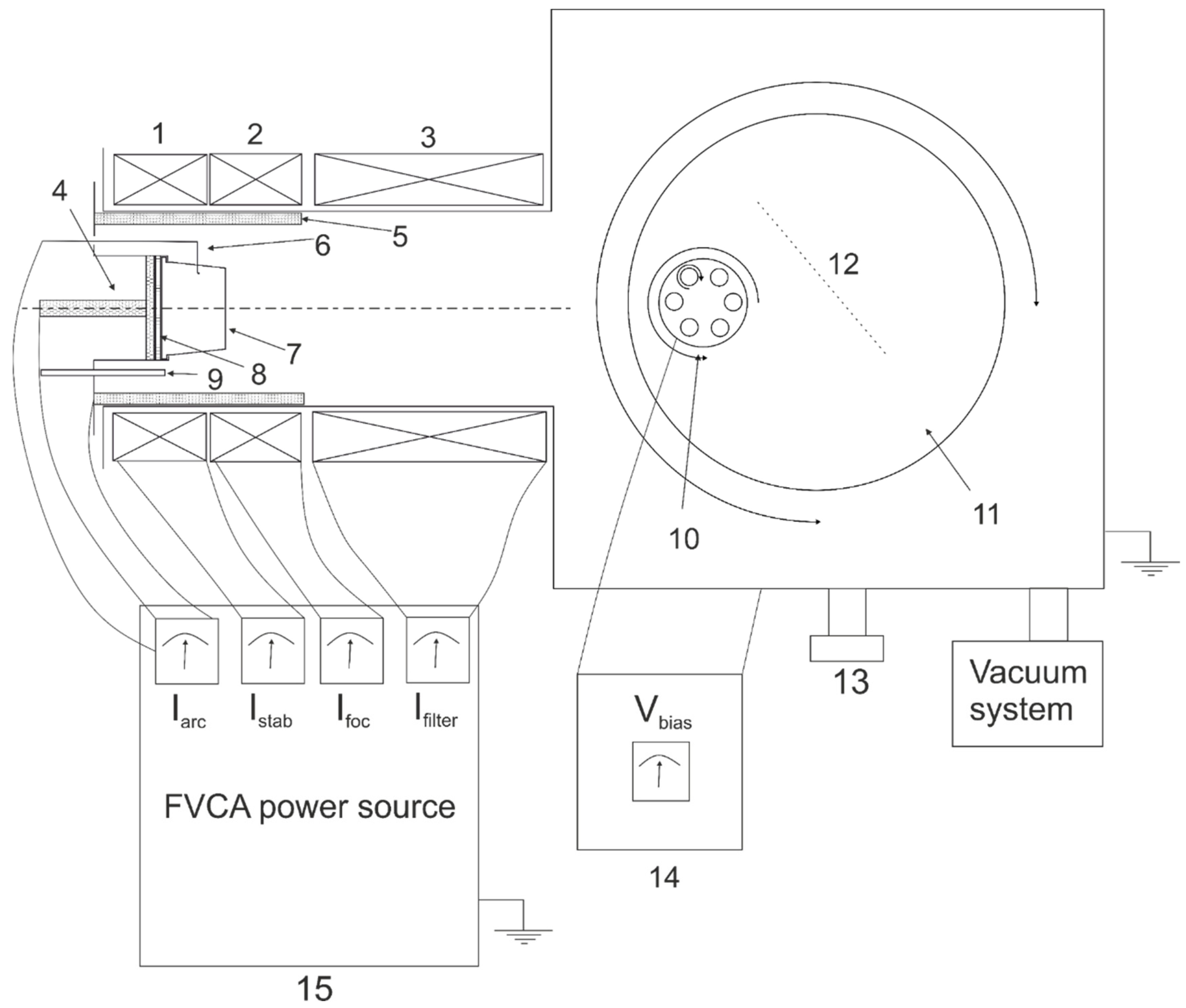
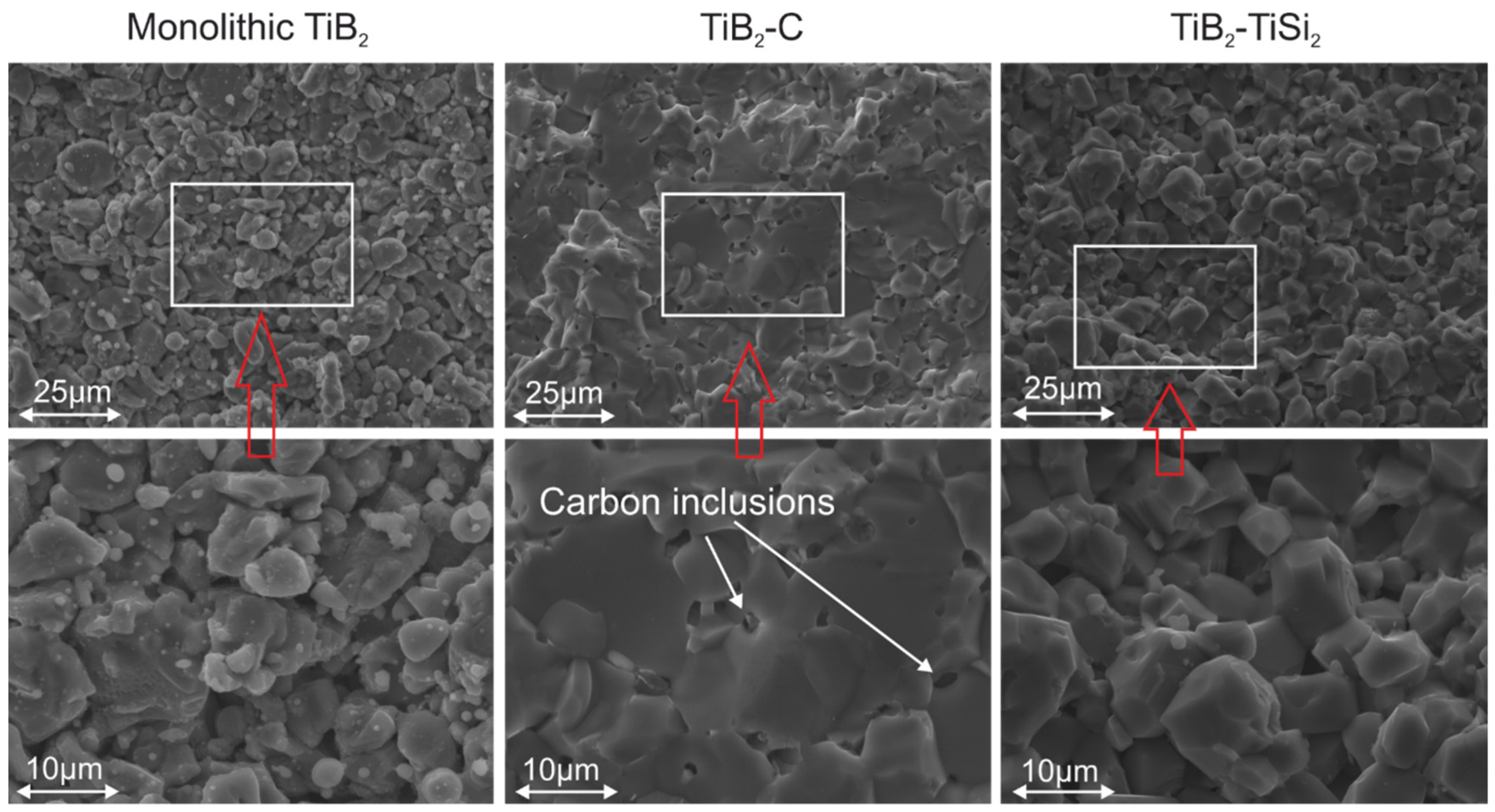
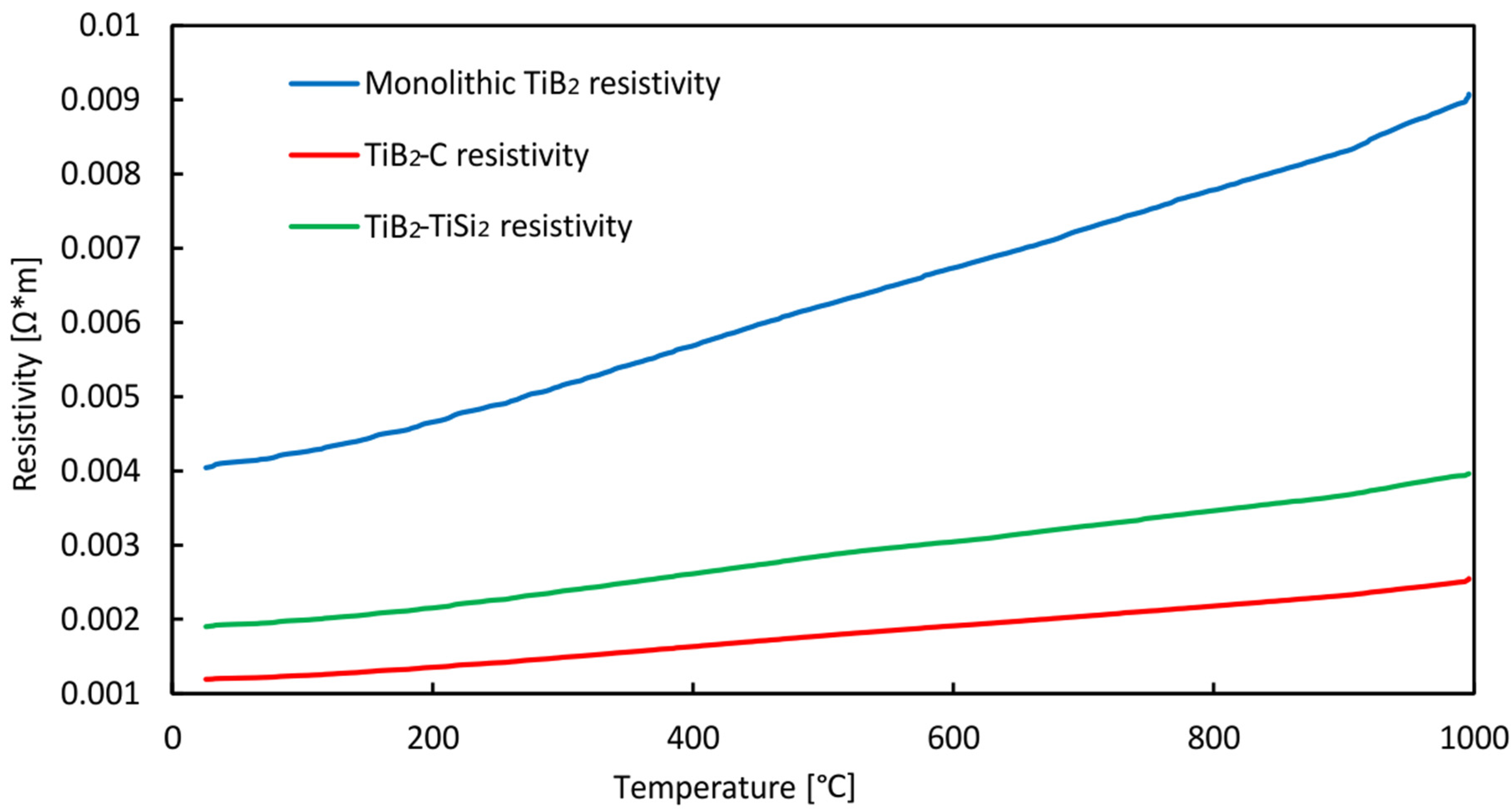
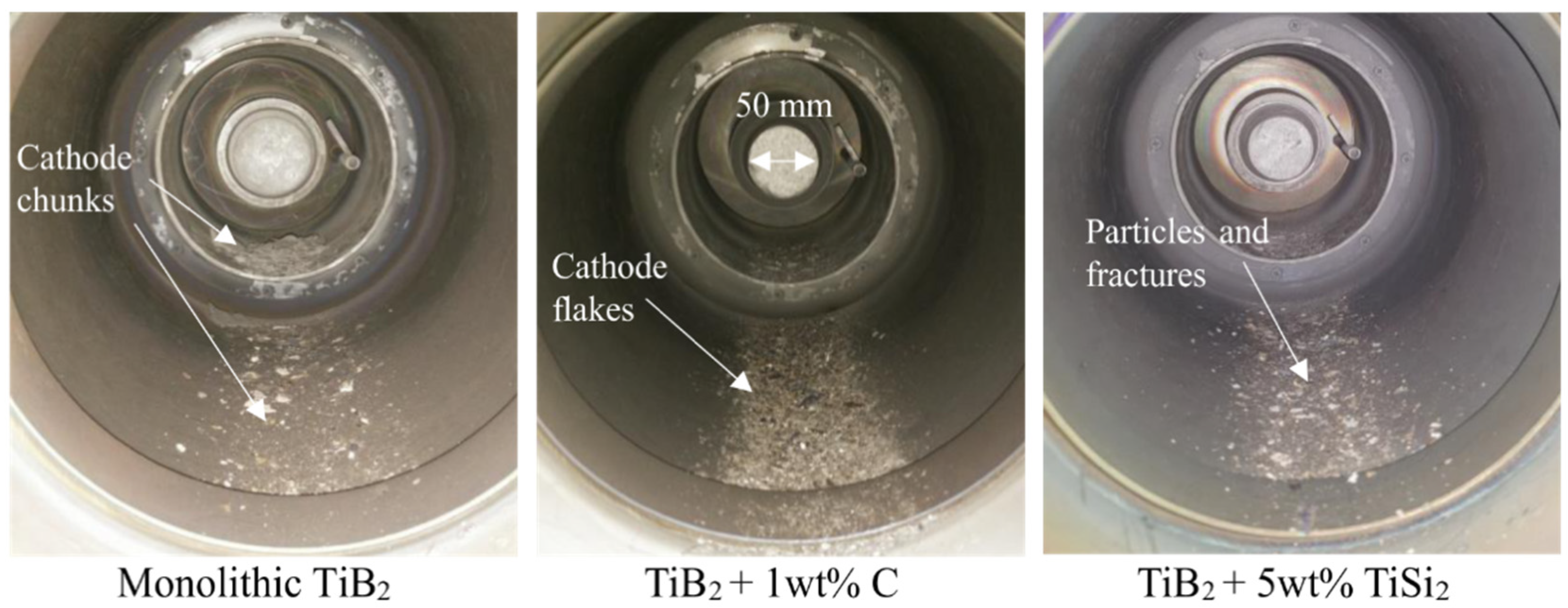
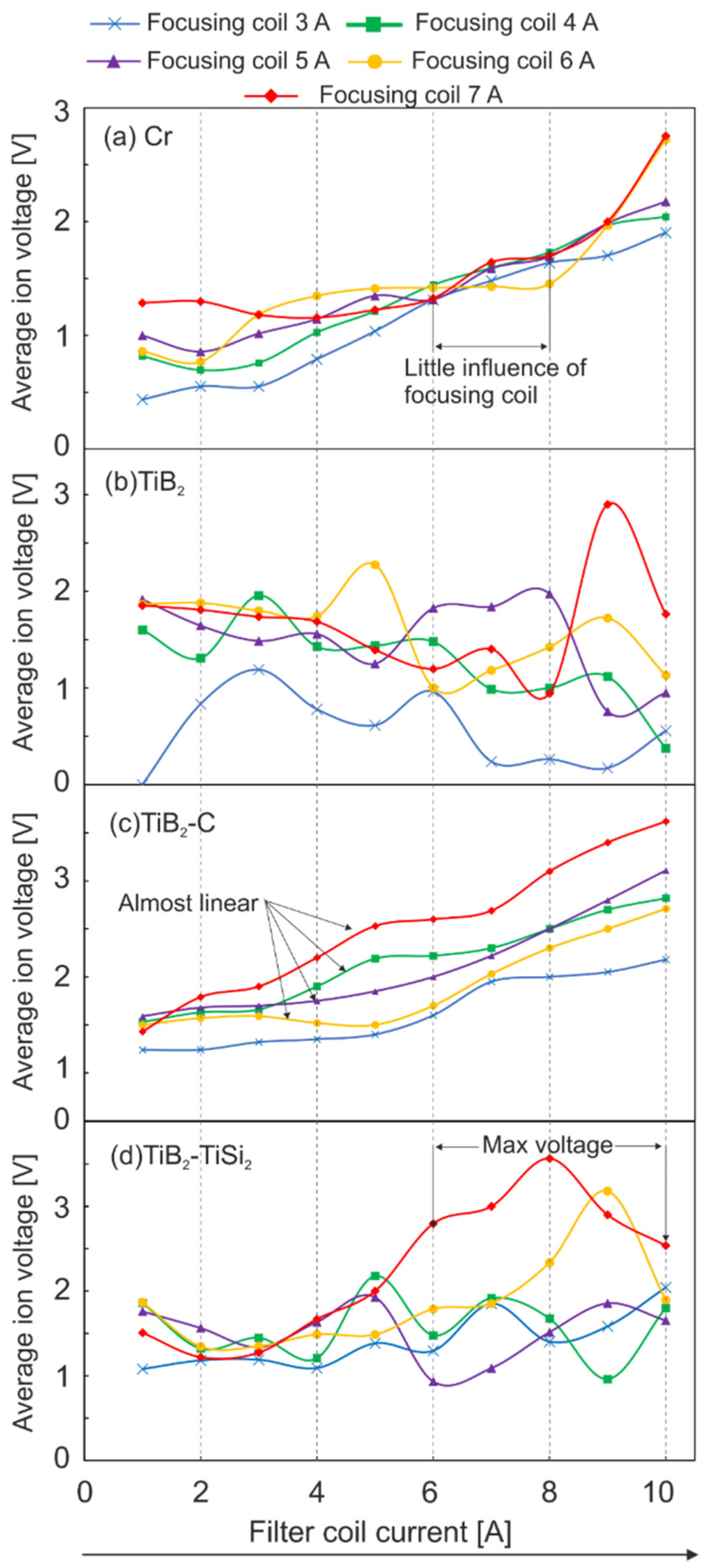
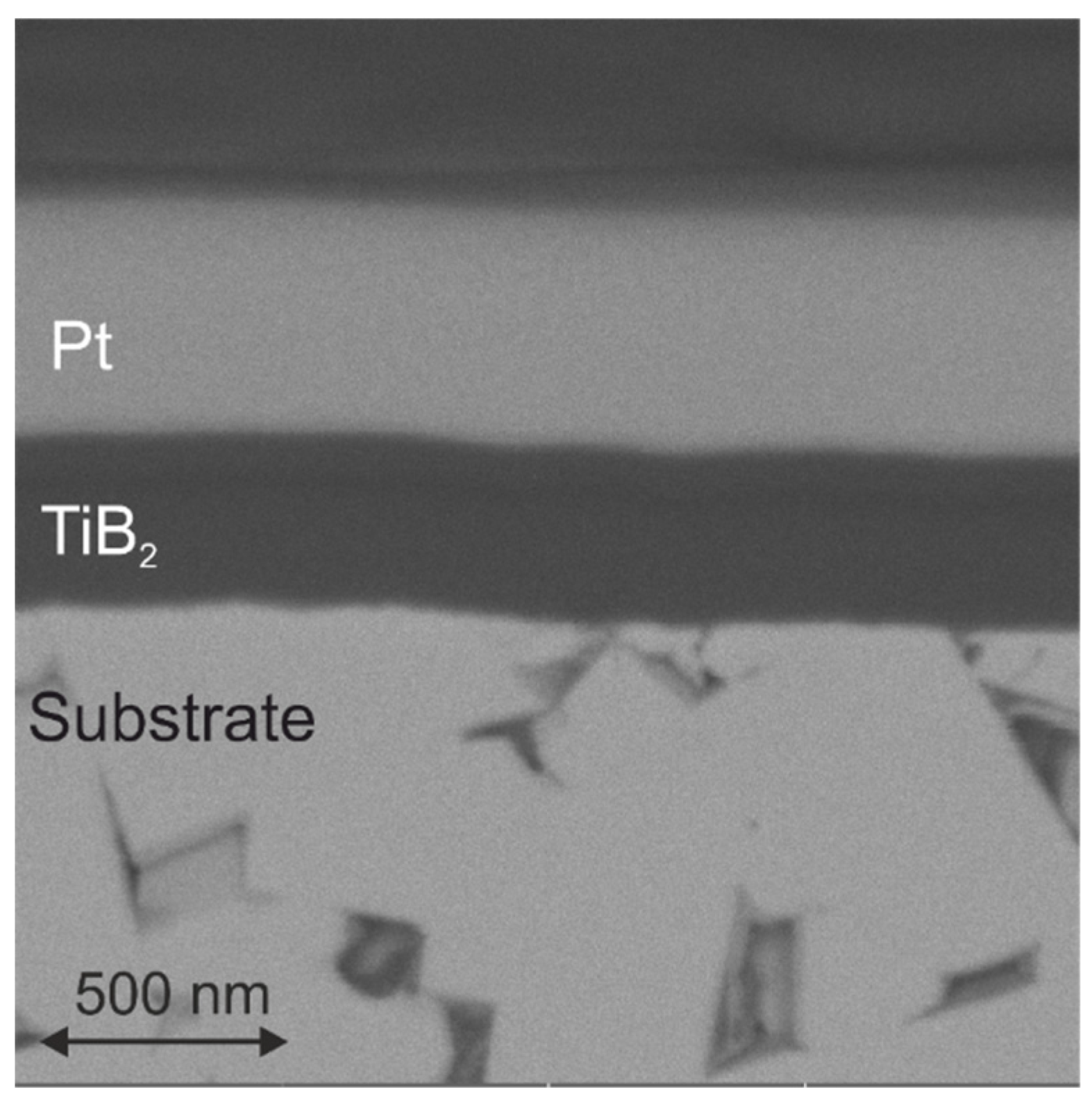


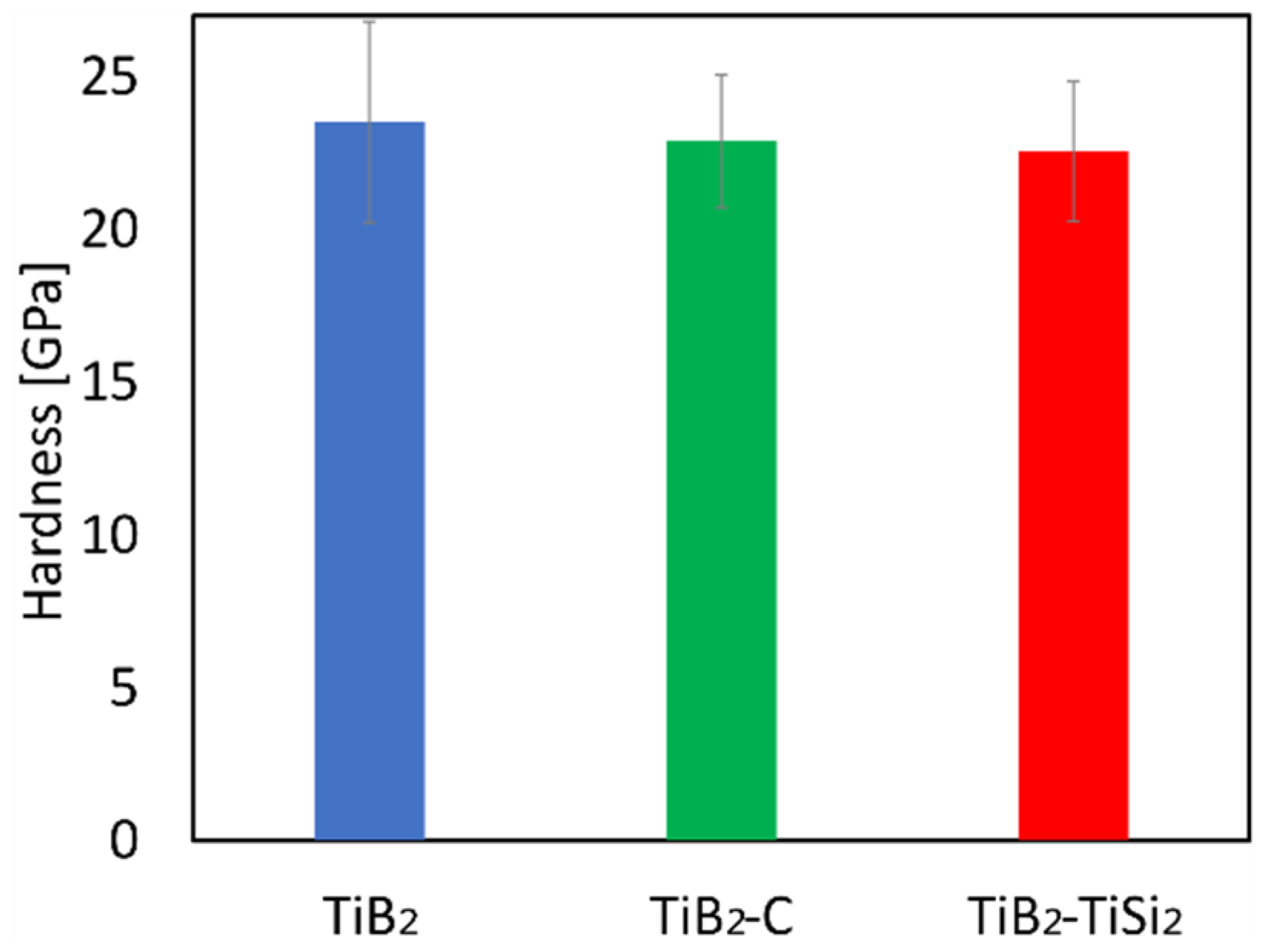
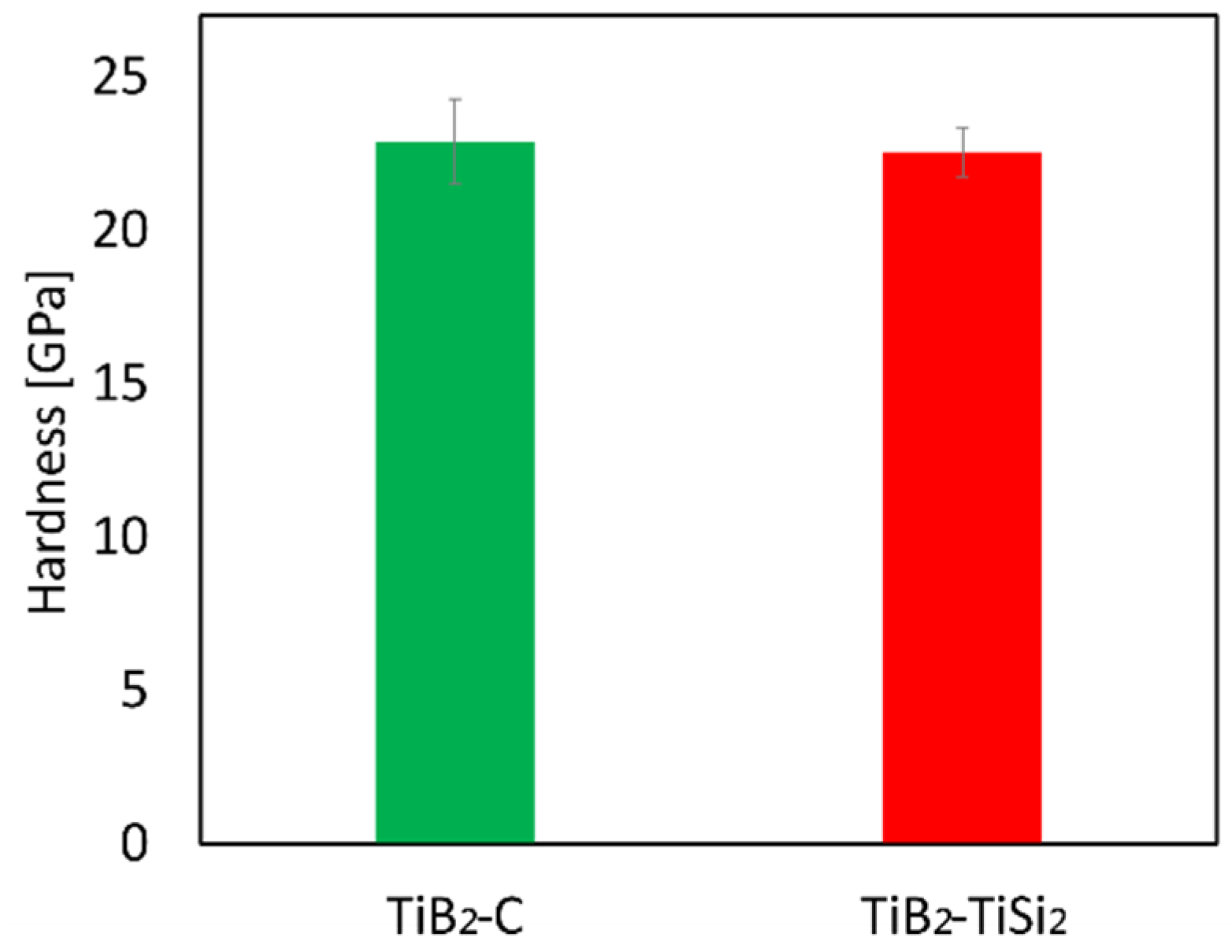
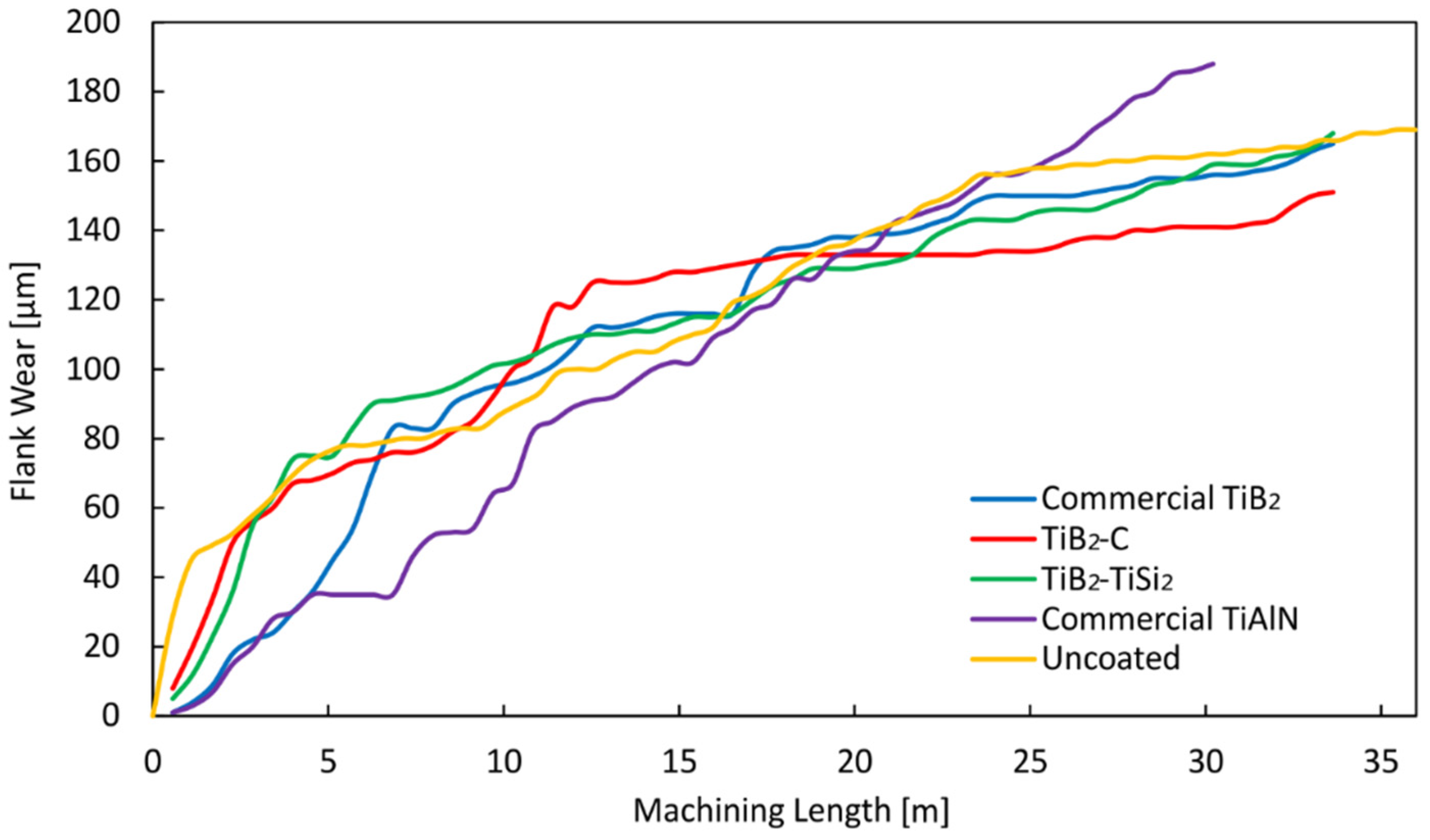
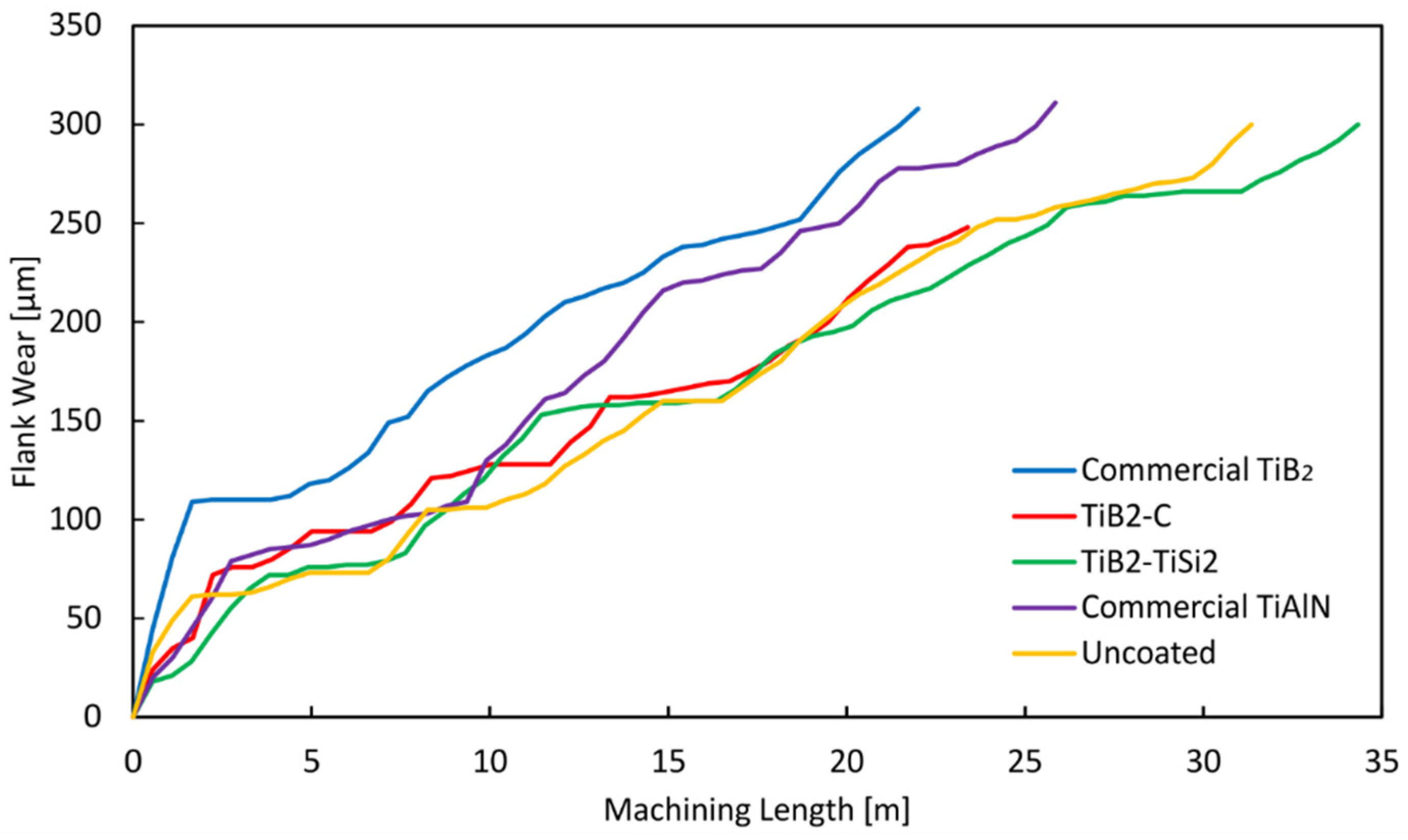
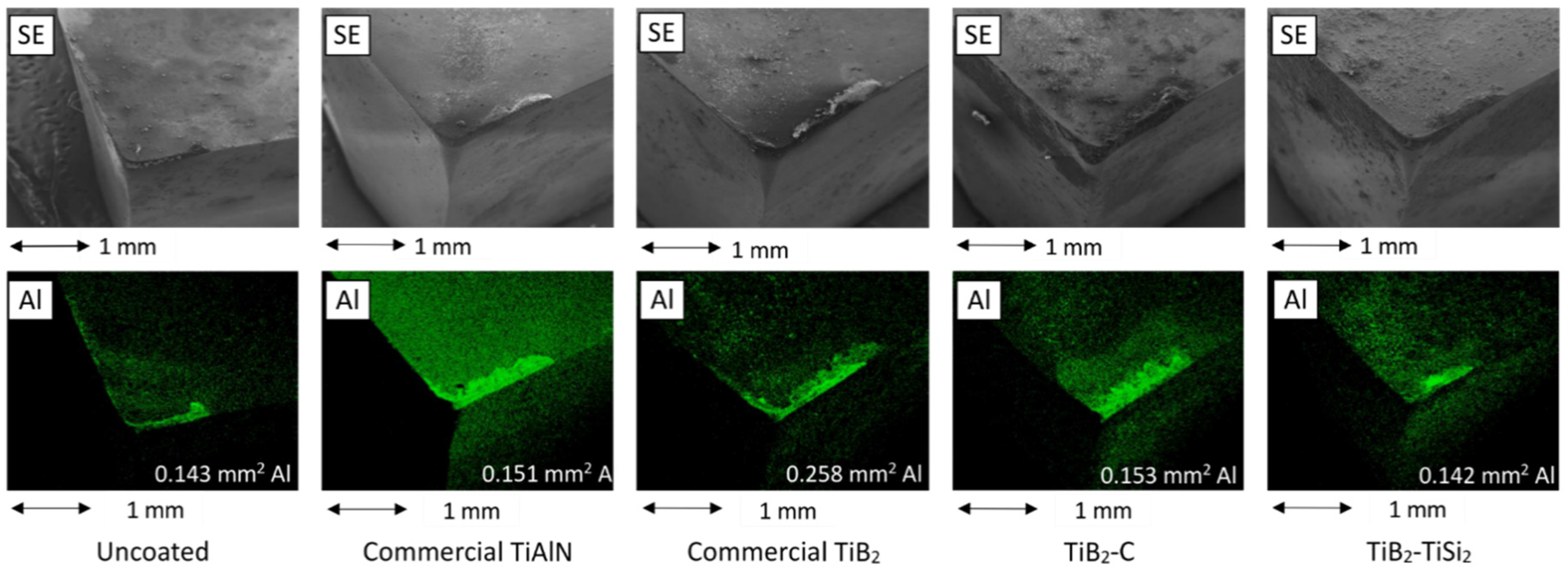
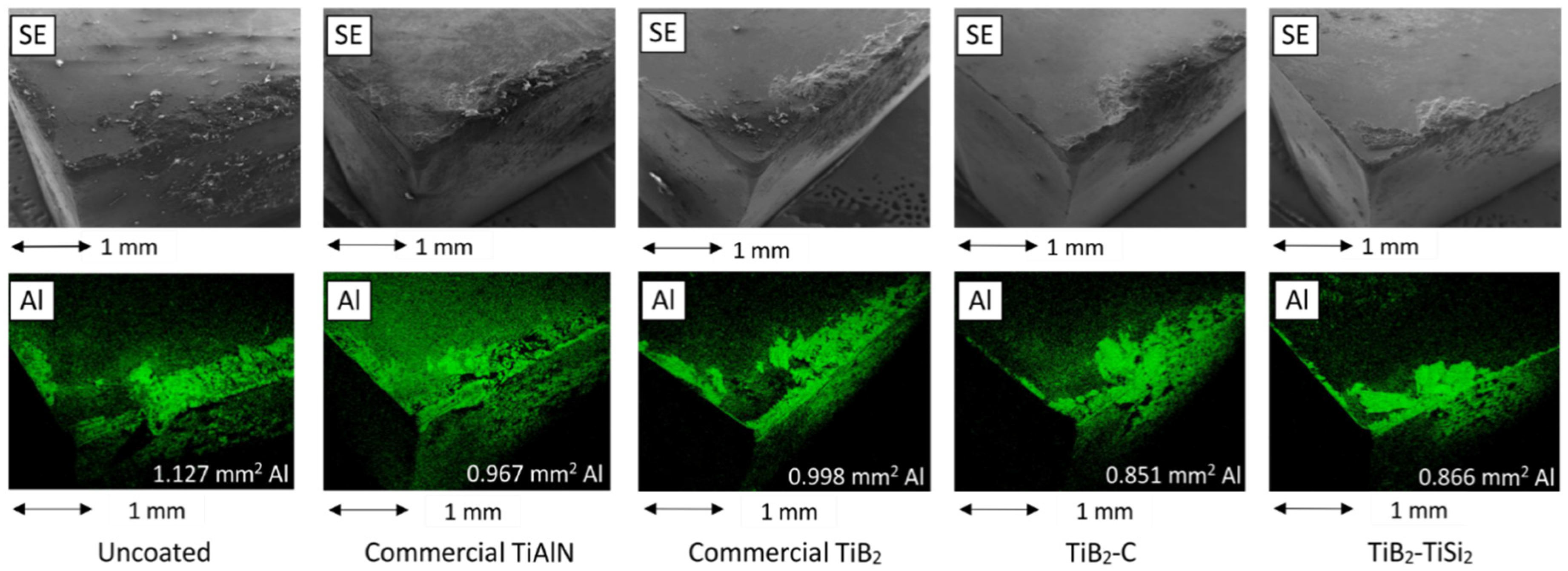
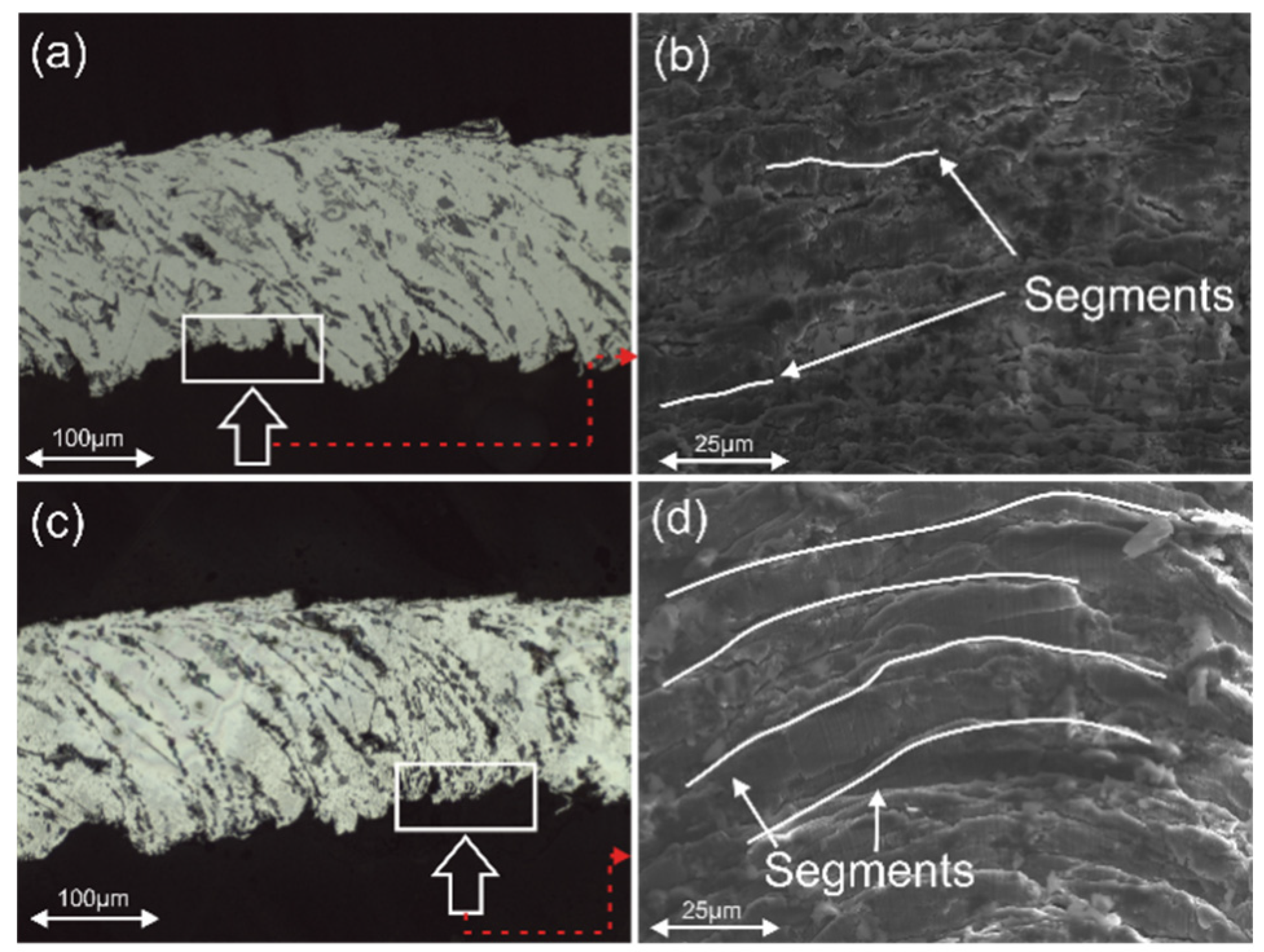
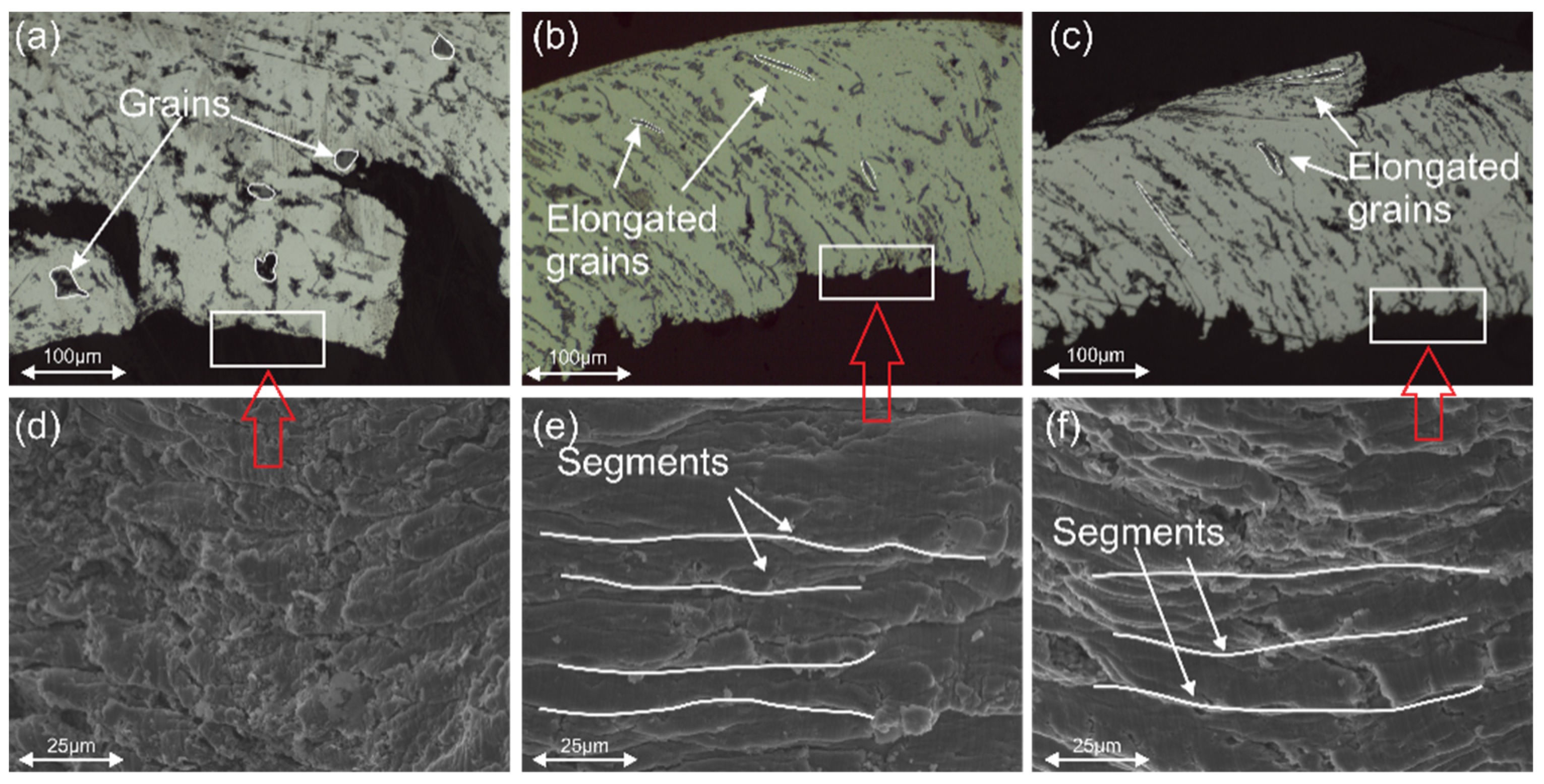
| Machine Tool | CNC Vertical Machining Centre |
|---|---|
| Number of cutting edges | 2 |
| Feed rate [mm/min] | 1880 |
| Feed per tooth ft [mm/tooth] | 0.05 |
| Cutter diameter [mm] | 19 |
| Tool speed RPM [rev/min] | 6300 |
| Axial Depth of cut ap [mm] | 10 |
| Radial Depth of cut [mm] | 1 |
| Cutting speed Vc [m/min] | 375 |
| Coolant rate flow [l/min] | 44 |
| Coolant concentration [%] | 6 |
| Workpiece material | Al-10Si (EN AB-43400) |
| B (at%) | Ti (at%) | C (at%) | Si (at%) | O (at%) | |
|---|---|---|---|---|---|
| TiB2 cathode | 67 | 31 | 2 | ||
| TiB2-C cathode | 59 | 27 | 13 | 1 | |
| TiB2-TiSi2 cathode | 52 | 23 | 5 | 20 | |
| TiB2-TiSi2 coating | 30 | 20 | 8 | 29 | |
| TiB2-C coating | 31 | 15 | 22 | 12 |
| Deposition Time | Coating Thickness [nm] |
|---|---|
| 20 min | 200 |
| 40 min | 400 |
| 100 min | 780 |
© 2020 by the authors. Licensee MDPI, Basel, Switzerland. This article is an open access article distributed under the terms and conditions of the Creative Commons Attribution (CC BY) license (http://creativecommons.org/licenses/by/4.0/).
Share and Cite
Brzezinka, T.L.; Rao, J.; Paiva, J.M.; Azkona, I.; Kohlscheen, J.; Fox Rabinovich, G.S.; Veldhuis, S.C.; Endrino, J.L. Facilitating TiB2 for Filtered Vacuum Cathodic Arc Evaporation. Coatings 2020, 10, 244. https://doi.org/10.3390/coatings10030244
Brzezinka TL, Rao J, Paiva JM, Azkona I, Kohlscheen J, Fox Rabinovich GS, Veldhuis SC, Endrino JL. Facilitating TiB2 for Filtered Vacuum Cathodic Arc Evaporation. Coatings. 2020; 10(3):244. https://doi.org/10.3390/coatings10030244
Chicago/Turabian StyleBrzezinka, Tomasz L., Jeff Rao, Jose M. Paiva, Ibon Azkona, Joern Kohlscheen, German S. Fox Rabinovich, Stephen C. Veldhuis, and Jose L. Endrino. 2020. "Facilitating TiB2 for Filtered Vacuum Cathodic Arc Evaporation" Coatings 10, no. 3: 244. https://doi.org/10.3390/coatings10030244
APA StyleBrzezinka, T. L., Rao, J., Paiva, J. M., Azkona, I., Kohlscheen, J., Fox Rabinovich, G. S., Veldhuis, S. C., & Endrino, J. L. (2020). Facilitating TiB2 for Filtered Vacuum Cathodic Arc Evaporation. Coatings, 10(3), 244. https://doi.org/10.3390/coatings10030244








